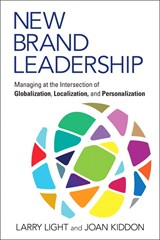Managing A Global Brand
Building a global brand today is different than it was only a few years ago. Globalization, localization and personalization are forces that impact how to best manage a global brand. In Larry Light and Joan Kiddon’s new book, New Brand Leadership: Managing at the Intersection of Globalization, Localization and Personalization, the authors share their over 50 years of experience in building the world’s largest brands. From forming a brand vision to measuring its performance, they share a framework for developing and executing a global brand strategy.
Recently, I had the opportunity to talk with Larry Light about his new work. Larry is the CEO of Arcature LLC. He was a senior executive and board member at BBDO and President of the international division of Ted Bates. He was Global CMO of McDonald’s from 2002 to 2005. More recently, Light was the Global Chief Brands Officer of IHG.
Bad Habits That Inhibit Brand Building
Would you share the bad habits that inhibit brand building? I found myself nodding and think readers would find these compelling.
We identified 15 bad habits that impede organizations from building brands, regardless of industry, category, and geography. These habits are not stand-alone forces: there are two underlying connections among these, and these are enterprise culture and leadership. First, culture matters. When there is a conflict between culture and strategy, culture wins. Culture fights change. Culture fights for the status quo. Culture nurtures complacency. Second, brand leadership is different from brand management. Brand management is taught in business schools. Effective brand leadership is different. Brand management is about the execution of specific brand-building actions. Brand leadership is different. It is about getting the right results through the efforts of others. It is about educating, inspiring, influencing and evaluating. Effective leaders create results by getting others to do the right things to produce the right results. Effective brand leadership is top down. For example, none of the work we did at McDonald’s could have happened without the leadership of Jim Cantalupo and Charlie Bell. Nissan needed Carlos Ghosn. IBM needed Lou Gerstner. Popeye’s needs Cheryl Bachelder.
15 Bad Branding Habits
- Complacency
- Change for the Sake of Change
- Financial Engineering as a Growth Strategy
- Cost-Managing the Way to Profitable Growth
- Focusing on Customers You Do Not Have at the Expense of Customers You Do Have
- Failing to Keep the Brand Relevant
- Price Segmentation Instead of Market Segmentation
- Thinking the Lowest Price Is the Same as the Best Value
- Failing to Instill a Quality Mind-Set
- Silo Mentality
- Focusing on the Short-Term Rather Than Creating a Short-Term/Long-Term Strategy
- Not Sharing Across Functions, Geographies, and Brands
- Believing the Regions Are Not as Sophisticated as the Center
- Believing That Brand Management Is All About Marketing Communication
- Allowing Data to Decide
The Most Insidious Bad Brand Building Habit
What’s the most common bad habit you have witnessed?
One that is becoming increasingly visible and insidious is the desire to satisfy the demands of Wall Street over satisfying the demands of customers. Ultimately, the sustainable source of cash flow comes from customers exchanging money for your offer. Financial engineering is not the basis for enduring profitable growth. Managing money is not the same as managing brands. Stock buybacks and increased dividends indicate that a company believes that investing in product and service development, innovations and brand-building will not yield satisfactory returns to shareholders. So, they just give cash back to shareholders and let them decide where to invest.
The Evolution of Global Marketing
How did you develop the 3 box model?
We have been involved in marketing for national and global brands for decades. Global marketing has evolved from the “one-box” approach of global standardization to the “two-box” approach of “think global; act local.” We have lived and worked through these two eras. In the current fast paced, digital, mobile, information-based, interconnected world, a new approach is necessary. A new approach is needed to address the very challenging conflict of the collision of three forces: increased globalization, increased localization, increased personalization. We call the new approach, the “collaborative three-box” model of (1) define the brand vision; (2) define the brand framework; (3) freedom within a framework.

What is one branding exercise you worked on that stands out as memorable?
The experience that stands out as the most memorable is our experience in helping to lead the turnaround of McDonald’s from 2002 to 2005. McDonald’s was in a desperate condition. The business was in desperate need of revitalization. Market share was in decline, franchisee attitudes were seriously negative, employee morale was down, and share price reached an all-time low. In less than three years, the business turned around, and shares reached an all-time high. The brand returned to health, yielding quality revenue growth and creating positive momentum that lasted about seven more years.
3 Shaping Forces
Globalization, localization and personalization are three forces you say we are all already affected by. Who is handling this well?
The effect of these forces affects all brands, large or small, global or local, product or service, consumer or business. We are living in a global information marketplace. Local relevance is essential to effective marketing. And, people want to be recognized as individuals. They want their distinctive needs to be respected. They also want to be personally involved. Brands have a great opportunity to evolve their communications to address this evolving desire.
What advice do you have for brand builders who find they are too often on the receiving end of strategy instead of influencing it?

Leadership makes a difference. If the company has a leader who sees brand as messaging and media, then brand will be relegated to a mere communications role. If the CEO and the CFO favor financial engineering, then the brand will suffer. It is the job of the CMO to be a leader and not just the senior executive in charge of brand management. The CMO is the executive in the C-suite who must make the case for a coherent business-building brand strategy. Companies must integrate the business plan and the brand plan into a single plan – the brand-business plan with one set of brand-business metrics. Brand strategy and corporate strategy need to be fully-integrated into a common plan of action. With this approach, brand-builders are not segregated receivers of the strategy; they are part of creating the strategy. They are not separated from the business strategy; they are contributors to the development of the business strategy.
Any global branding disasters you would like to discuss?
It has been extensively reported that McDonald’s is a troubled brand. The positive momentum that was created prior to 2005 covered up the fact that McDonald’s planted the seeds of brand destruction from 2006 to 2012. The brand lost focus. Menu expansion got out of control. Operational complexity increased. Service times increased. Product quality declined. McDonald’s focused on the financial community at the expense of the customer experience. Today, the brand seems to be focused on its indirect competition (e.g. Chipotle) while it is losing business to its direct competitors (e.g. Burger King, Wendy’s, Chick-Fil-A). After several years of outstanding business performance, McDonald’s is experiencing severe brand erosion. McDonald’s revenue fell by $2.28 billion over the past year.
What global brands would you say are doing a great job of managing a global brand?
Mars is a good example of a company that manages its brands very well around the world. They optimize the balance of global scale with local relevance. They provide a variety of options to meet personal needs at a variety of occasions. They even encourage the personalization of M&M’s. Toyota is another good example. Toyota globalizes its brand identity through six functional design cues that make a Toyota a Toyota while addressing local market uniqueness. Amazon and Google achieve an excellent balance addressing the three forces of globalization, localization and personalization.
New Brand Leadership: Managing at the Intersection of

